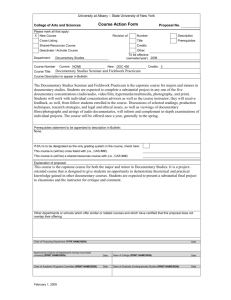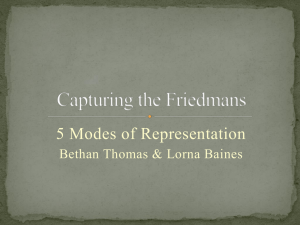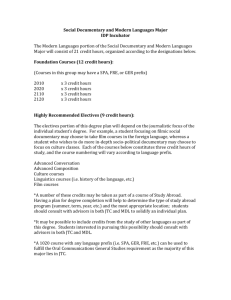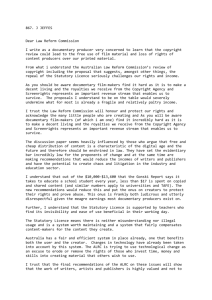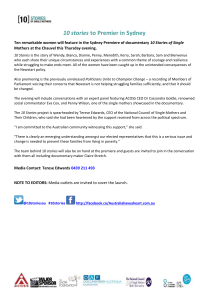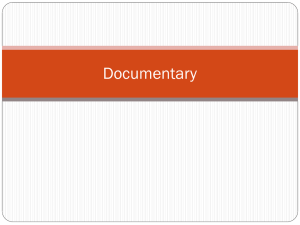Co-creative Documentary as DiWO Citizenship
advertisement
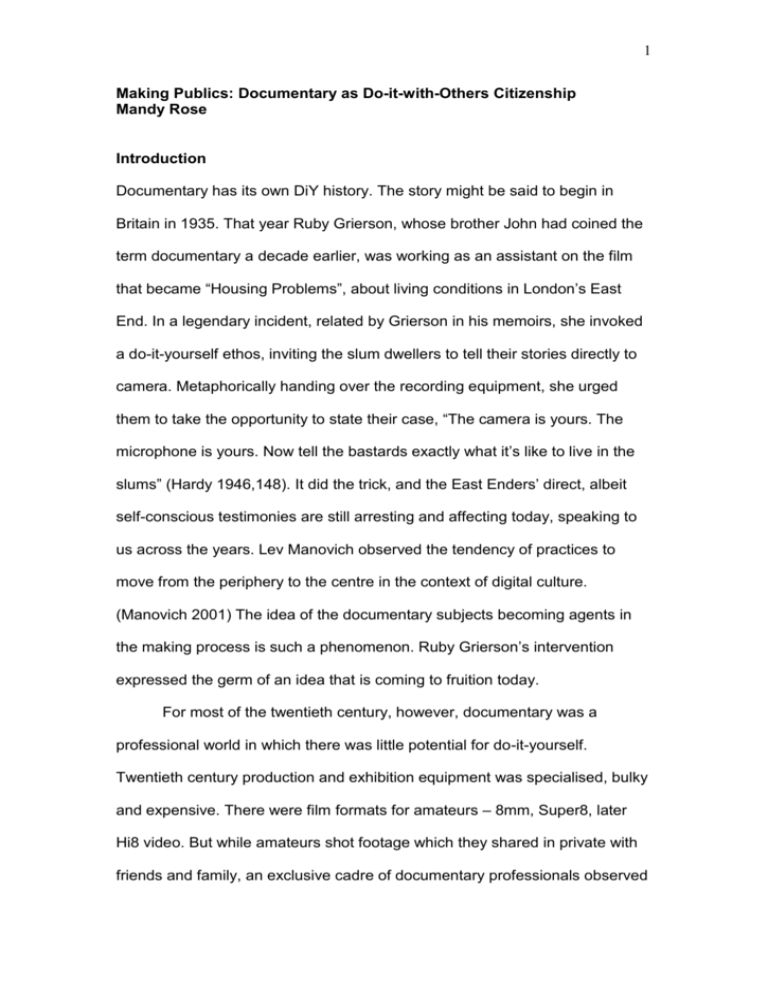
1 Making Publics: Documentary as Do-it-with-Others Citizenship Mandy Rose Introduction Documentary has its own DiY history. The story might be said to begin in Britain in 1935. That year Ruby Grierson, whose brother John had coined the term documentary a decade earlier, was working as an assistant on the film that became “Housing Problems”, about living conditions in London’s East End. In a legendary incident, related by Grierson in his memoirs, she invoked a do-it-yourself ethos, inviting the slum dwellers to tell their stories directly to camera. Metaphorically handing over the recording equipment, she urged them to take the opportunity to state their case, “The camera is yours. The microphone is yours. Now tell the bastards exactly what it’s like to live in the slums” (Hardy 1946,148). It did the trick, and the East Enders’ direct, albeit self-conscious testimonies are still arresting and affecting today, speaking to us across the years. Lev Manovich observed the tendency of practices to move from the periphery to the centre in the context of digital culture. (Manovich 2001) The idea of the documentary subjects becoming agents in the making process is such a phenomenon. Ruby Grierson’s intervention expressed the germ of an idea that is coming to fruition today. For most of the twentieth century, however, documentary was a professional world in which there was little potential for do-it-yourself. Twentieth century production and exhibition equipment was specialised, bulky and expensive. There were film formats for amateurs – 8mm, Super8, later Hi8 video. But while amateurs shot footage which they shared in private with friends and family, an exclusive cadre of documentary professionals observed 2 and interpreted the world on our behalf, shaping footage into real-life stories that circulated in the public sphere. At the same time, the subject of social documentary is people, and production is based in a relationship between filmmaker and human subject/s. While the dominant practice within documentary has been that the filmmaker generates the content – film, video, stills - and shapes an interpretation of the world from that material, the documentary subject has generally been afforded no agency in that process. The idea of the documentary subjects’ rights has surfaced notably alongside political movements through which those excluded from systems of power have fought for their voice to be heard. In Paris, May ‘68, film was seen as a central arena of the struggle. Technicians and film resources were put at the disposal of protesters and Renault workers produced a film. Across the Atlantic in Canada that same year a model of media access was pioneered within the Challenge for Change project, when director George Stoney agreed a proposal from his team to hand cameras over to Native Americans who were protesting customs charges on a bridge across their land. Inspired by “You are on Indian Land” and the Challenge for Change output that followed it, forms of access media were then developed in North America and in the UK in the 70s. This DiY current within documentary – expressed through making tools and facilitation available so that non-professionals the people might create and present their own documentary arguments – continued through the latter years of the twentieth century, in Community Media and Access TV, at the margins of dominant media practice. Today, we can see not just DiY as amateur made, participatory content 3 within documentary, but the broader development of what we might call a DiY Culture which is emerging where documentary meets the affordances of the social, semantic and open web. In this space we find remix video, open rights frameworks, crowd funding as a form of democratised commissioning. Here we are seeing the development of open source web documentary authoring environments (Zeega, Popcorn Maker) and nascent forms of web native production culture in which film makers, interaction designers and coders approach project development through hackathons. This culture is located outside corporate and consumer relationships. It values read/write forms over passive spectatorship. It promotes new media literacies. It sees documentary as a stage for an interrogation of contemporary systems of power. Brett Gaylor’s open source collaborative 2008 documentary “RIP! A Remix Manifesto” exemplifies this culture. All these activities deserve critical attention, but there is not the space to address them all here. In this chapter I will focus on significant collaborative, interactive documentary practices that are emerging in the context of digital culture. In the first part of the chapter I’m going to think about these forms of collaborative documentary in relation to the concept of DiY in its original sense of amateur making. This framework can help to situate these emerging practices in relation to the counter-history within documentary in which subjects have taken on forms of agency and editorial control in the production process. By using contemporary examples I will then suggest why the concept of DiY is problematic for documentary. Awareness that a DiY approach to documentary making is not universally available, prompts a questioning of the 4 valorisation of the concept of DiY in the context of complex media production. Through the lens of co-creativity I will discuss collaborative documentaries as a strategic response to the ‘participation gap’ (Jenkins 2006, 23). But there is more than this at stake in these collaborative documentary practices. In my view, the concept of DiWO (Do-it-With-Others) is better equipped to capture the dynamics and importance of these projects. A cocreative, DiWO approach to documentary provides a progressive re-working of documentary’s historic role in the public sphere, as an open space for dialogue and a stage for the performance of citizenship. DiY or Collaborative? The DiY current in documentary is finding expression in a growing body of North American work based on collaborative processes and involving public participation. These projects routinely incorporate the amateur, DiY media often known as user-generated or (my preference) participatory content. I will begin by considering two such documentaries that provide rich material for revealing the limits of the term DiY to describe current trends. Eighty years after “Housing Problems”, Elaine McMillion, the director of the forthcoming “Hollow” project, might be seen as Ruby Grierson’s heir. Within this work-in-progress McMillion has returned to her childhood home – McDowell County, West Virginia - to create, in the words of the project website, a “hybrid community participatory project and interactive documentary” that addresses ‘the many stereotypes associated with the area, population loss and potential for the future.” Appealing for funding on Kickstarter, McMillion describes the project’s mission as; “Exploring the issues and future of rural America through the eyes and ideas of those living in 5 Southern West Virginia.” For McMillion and her team, representation is a central factor in the area’s disenfranchisement. Story director Jason Headley writes; “Most of the thoughts and opinions of our state are formed by outside forces looking in. This project gives us the chance to do the exact opposite. To let people see West Virginia from the perspective of the people who live here.” As well as taking a conventional documentary approach - filming people talking about their lives and situations - the participatory engagement outlined for Hollow includes workshops to support local people in making twenty of the fifty short documentaries planned for the site. These elements will be brought together within an interactive online proposition to provide a broad audience with a picture of local life at the same time as providing a platform for community dialogue about current and future directions. While the work is still unfinished, comments in a “What the Community is Saying” section of the Hollow website suggest that the production to date has been well received locally. A second example, Mapping Main Street (MMS), shows how the concept of DiY plays out in another comparable collaborative project. MMS came about as a response to the way that politicians were invoking the idea of Main Street during the 2009 US election campaign as a cipher to express their vision of America. This isn’t a new tendency. Project co-creator Jesse Shapins has noted that Main Street has long been the subject of debate in America, proving “a highly contested shifting metaphor for what constitutes traditional American values and the “average” American experience” (Shapins 2009, 2). The intention of the project, co-creator Kara Oehler explained in an 6 interview with the author, “was really to point out the diversity and differences between all of these different places.” The shape of the MMS project was then designed to mobilise a reflective and creative response to the subject of Main Street today; to catalyse multiple situated stories around this contested idea. These would take the form of stand-alone documentary shorts that could be brought together to present a grassroots view of American life. Shapins and Oehler knew from experience of previous participatory projects that a call-to-action in itself would not generate a substantial, diverse response. They needed to spread the word about the project, show potential contributors what they were looking for, build partnerships and encourage involvement. So in May 2009 Oehler and Shapins set off on a 12,000 mile journey through the Main Streets of the USA, to gather audio stories and stills as seed content for the website. That journey generated content that became a radio series on National Public Radio (NPR), who had supported the initial project through the Makers Quest 2.0 scheme. Starting with this substantial exposure, their “Collaborative Documentary Media Project” has been evolving and growing ever since, with 829 streets covered at the time of writing. In what sense though is the project collaborative? In what sense might it be regarded as DiY? Both MMS and Hollow involve forms of public participation, but inspected in closer detail, they suggest problems in the simplistic framework of DiY. For a start, there is no clear amateur / professional binary at work between content made by participants and project producers. Some contributions are by experienced media makers, while others are by 7 journalists in the making. MMS has been a platform for the NPR Radio Rookies training scheme, for example. These contributions from trainees might be described as amateur but probably not as DiY, in that they are mediated by trainers, which is at odds with the idea of self-direction fundamental to the concept of do-it-yourself. Does this devalue this participatory content? The next section considers this question by asking how those taking part assess these experiences of participation. Participation to Co-creation How is it possible to gauge the success of these collaborative projects from the point of view of participants and therefore assess their potential impact on communities? Unfortunately there is little independent evidence to draw on. However, a reading of the “What the Community is Saying” section of the Hollow website proves instructive. The statements are interesting from a number of points of view. There is a recurrent theme that the project has provoked something important within individual and collective self-perception; “I feel like I have contributed to something important and it has changed the way I see the world.” “I’m not sure I can explain the hope and sense of community that Hollow has inspired.” “I think it will inspire the residents of McDowell County to see the efforts of their neighbors to make changes for the better here where we all live.” There is a dynamic within which McMillion is constructed as a benefactor, almost a saviour; 8 “thankful to Elaine McMillion and her team for what they have done to show McDowell County in a positive light…it’s time the world knows that we aren’t as mainstream media portrays us. We are BETTER!” “She has given us our county back, our voices back, and we can never thank her enough for that!” What comes across is that people feel they have no means to represent themselves without the intervention of an outside agent. The comments are reminiscent of the tone of feedback obtained by a journalist who talked to participants about the Access TV project Video Nation which I co-produced at the BBC in the 1990s. One said, “I has a hard upbringing. My parents forced me to give up school at sixteen. I had no qualifications, not one. Doing Video Nation has given me a massive lift. The BBC actually listens to me Conrad Gorner” (France,1999). At that time, participants expressed feelings of affirmation as a result of being heard on the BBC, and gratitude to the team who facilitated that experience. This was in the pre-internet era, when there was no other route to self-representation in the media. Almost twenty years later, the comments about Hollow demand to be read in the context of rhetoric of universal participation. The comparison points up the continuing lack of media participation that is still the reality for many. Henry Jenkins (2006) has called this phenomenon the ‘participation gap’, whereby, despite the existence and apparent accessibility of digital creative technologies people are still excluded from taking part. Uneven 9 participation may be less to do with the lack of access to equipment or technologies sometimes referred to as the ‘digital divide’, and more to do with a lack of confidence in and understanding of the protocols of engagement. Participation is not open to all, Jenkins pointed out, but constrained and circumscribed by social context. And while the ease of use offered by Facebook and Twitter has allowed diverse new participants to post on social media platforms in recent years, there is a difference between publishing a post to communicate with friends and family and telling stories using rich media. A reading of the comments made about Hollow problematises a valorisation of DiY in the context of complex media making. In this light a number of these collaborative and participatory projects – including Mapping Main Street and Hollow, but also the National Film Board of Canada’s award winning Highrise - can be seen to be adopting a production strategy that responds to the participation gap. This can entail facilitating participation by members of marginalised communities while at the same time giving them forms of authority in the production process. But the term ‘collaborative documentary’ is not unique to these projects. It is also used to describe collaborations among experienced filmmakers. “99 Percent: The Occupy Wall Street Film” is one such current example. Since it is often undefined the term collaborative can confuse, raising expectations of equal contribution and collective decision-making. An alternative framework is provided by the term co-creative media – a concept which is being refined by researchers at QUT in relation to digital storytelling projects and community media. “Co-creative media provides a tool for describing the ways in which participatory media are facilitated by people 10 and organisations, not just technology…” (Spurgeon et al. 2009, 275). The term arises from a recognition of the participation gap, and, “complicates the idea that participatory culture is the product of an autonomous relationship between the individual creator and the magic of technology.” (Ibid, 284) So how does this work in practice? The Author as Co-Creative Producer In the cases of Hollow and Mapping Main Street we can see how providing workshop-based facilitation, in the former case, and a platform that allows educators to get involved (on MMS) constitute specific ways of addressing the participation gap in the context of their respective themes. How then are we to understand the role of the producer of a collaborative and co-creative, interactive project? How does that role co-exist with a devolution of editorial control and authority? In what sense is their activity different from the traditional role of a documentary producer? Walter Benjamin’s 1930s essay, “The Author as Producer” provides an apt frame of reference. Considering the options for the engaged Marxist artist, Benjamin makes a distinction between self-expression and the work of providing a platform. He proposes that the task for the committed artist is to adapt “the production apparatus” (Benjamin 1977, 94), on behalf of the workers. “This apparatus will be the better”, he continues, “the more consumers it brings into contact with the production process – in short, the more readers or spectators it turns into collaborators” (Ibid., 98 ). At a very different historical moment this model is still relevant for these co-creative documentaries being made in the context of the participation gap. The distinction between production apparatus and content is particularly resonant 11 for these projects which involve the production of an architecture of participation and interaction as well as content itself. What does Main Street mean for you? How does life in West Virginia look to you? The producers behind these projects pose a question, but do not try to determine the answer. Their role is not a passive one, however; they work with what Benjamin calls a “mediating effectiveness” (Ibid.,102). They design architectures within which many responses can be gathered and presented; apparatuses for contribution and platforms for sharing and interaction. That is not to suggest that those architectures are neutral. Design, wording, the framing of the call to action: these present points-of-view. As the French interactive documentary producer Alexandre Brachet (2011) has said, “Interface is content”. Each project then expresses a political attitude to its theme. Participants are invited to join in a project that has an agenda, and at the same time they are provided with a platform through which they can express their own perspective and point-of-view. In taking part participants become a community to interrogate a theme of shared concern. The significance of these co-creative projects is not then reducible to the presence of do-ityourself, participatory content. It derives instead from the ways that the projects open out the range of voices that get to speak with authority and purpose within the documentary project. What’s at stake is documentary as catalyst for conversations, debates, understandings among participants, communities, audiences – its role in the public sphere. Documentary as Citizenship Documentary has long been associated with citizenship. Grierson 12 championed the form for its educative value, its promise to produce the informed citizen – a conception of documentary’s role in the public sphere that still lingers. Michael Chanan (2000, 229) has argued for an alternative view of the work of documentary; that its “vocation” in the public sphere derives instead from its dialogic aspect. For Chanan, documentary’s contribution consists in it being “internally dialogic, or double-voiced” (Ibid., 226). Documentary presents, “ a variety of individual and collective voices, and behind them, the voice of the film maker” (Ibid.,226). Writing in reference to linear documentary in the late 1990s, Chanan argued that this work with orchestrating multiple perspectives and subjectivities brought documentary close to a Habermasian conception of the public sphere as a space of dialogue and deliberation. Producers are now harnessing digital technologies, platforms, affordances in ways that amplify this dialogic character and transform the encounter between content and viewer / user. The presentation of the Mapping Main Street stories, for example, breaks in a significant way with the dialogic character of documentary as characterised by Chanan. Whereas a linear documentary on this theme might involve the reflection of “a variety of individual and collective voices”, structured and fixed by the film-maker within an argument, the deliberations of MMS are reflected in a diversity of perspectives and experiences that are presented without an overarching rhetorical structure. Writing about this open-ended form Shapins (2012) has said,“ There is something about collaborative and participatory processes specifically connected to documentary that foreground that dimension…. it’s not to sort of completely relativise – there are truths that exist in the world – 13 but I think it is to open up the possibility for having many different vantage points that can possibly help us get to different forms of understanding truth in the process.” Mapping Main Street then emphasizes the dialogic aspect which Chanan links to the public sphere. Presenting content from many people and places, it reflects but does not seek to synthesise a multiplicity of situated perspectives and knowledges, It takes advantage of co-creative production, non-linear technology and the database as a production tool to reflect that multiplicity, and asks the viewer / user to engage with and consider these diverse points-of-view. While I have argued that DiY is a problematic concept for thinking about these collaborative documentaries as media practices - because amateur participation is facilitated, mediated and co-created - the concept of DiY becomes valuable when thinking about these documentaries as citizenship practices. “Bottom-up, self organising, self-representing” (Hartley 2010) they take place outside conventional political forums and practices, staging purposeful dialogue among participants and with their audience. In a discussion of forms of playful ephemeral media – dance-offs, spoof videos as, “Silly Citizenship”, John Hartley adopts the term ‘Do-it-with-Others’ (DIWO) alongside or as an alternative to DiY. DIY/ DIWO Citizenship, he suggests, “is driven by voluntarist choices and affiliations, but at the same time it has an activist and communitarian ethic, where ‘knowledge shared is knowledge gained.’” Mapped on to the more sober terrain of these documentary projects this characterisation chimes with their co-creative and dialogic aspects while also highlighting the ethical dimension of participation – 14 the social and political purpose reflected in time freely given to dialogue and deliberation, as a contribution towards understanding and change. Conclusion A third and final documentary example serves to draw a number of these themes together and to point towards future developments for the documentary form. Question Bridge (QB) is an important co-creative undertaking in which participants don’t make content, though their contributions are the heart and driver of the piece. In the words of the QB website, this transmedia project, created by Chris Johnson, Hank Willis Thomas, Bayete Ross Smith and Kamal Sinclair, “seeks to represent and redefine Black male identity in America. Through video mediated question and answer exchange, diverse members of this "demographic" bridge economic, political, geographic, and generational divisions.” Participants are invited to offer a question that they would like to address to another black American man. Their questions - about racism, class, individual and collective responsibility - and the ensuing answers are filmed. The dialogue between participants produced through editing then makes up the work. Those taking part come together as a virtual community to interrogate their situations and challenge an oppressive, monolithic construction of their shared identity. The filming strategy is designed to maximize the viewer’s involvement. Close-up talking heads pose and answer questions directly to camera so that the viewer is positioned as the one being asked and being answered. Addressed as if a member of the community, she is brought into a complex affective space, called on as a peer to imagine and hear from many varied 15 perspectives how the world looks through African American men’s eyes. As an online experience, this has the intimacy of a one-to-one exchange. As an installation, this effect is created in another way - monitors are arranged so that the life-sized talking heads are at head height and the viewer is situated as part of the group. In both cases, the effect works to bring the viewer right into the dialogue, encouraging identification and disrupting the other-ness which is at play in a racist construction of black male identity. Like Hollow, the project is designed to work on two levels. It’s about a community – reflecting lived experience and complexity, and challenging pre-conceptions. It’s also for the community - a platform through which the participants become a public, calling attention to their common concerns. Here documentary becomes a stage for a performance of DIWO Citizenship. At the same time, new forms of exhibition and interaction reframe the audience experience to bring the viewer/user into a more dynamic relationship with the content. In doing so, they highlight an aspect of documentary which is obscured by the idea of DiY - its profoundly collaborative nature, and the way that documentary meaning is made in dialogue. Works Cited “99 Percent: The Occupy Wall Street Film”. Accessed December, 7, 2012, http://www.99percentfilm.com/ Brachet, Alexandre “Strategies of collaboration in i-docs” Keynote at i-Docs Symposium, Bristol, March, 25, 2011. 16 Chanan, Michael. “Documentary and the Public Sphere” in Grierson to the Docusoap: Breaking the Boundaries, edited by Izod, John, Kilborn, Richard and Hibberd, Matthew, 221-230. London: University of Luton Press, 2000. France, Louise. “Two Minutes of Fame” The Independent, March, 7, 1999, accessed December, 7, 2012, http://www.independent.co.uk/life-style/reallives-two-minutes-of-fame-1078911.html Hardy, Forsyth. Grierson on Documentary. California: Faber, 1946. Hartley, John. “Silly Citizenship” Critical Discourse Studies; Special Issue: Self-Mediation: New Media and Citizenship 7 vol. 4 (September 2010): 233-248 Accessed December, 7, 2012, http://www.tandfonline.com/doi/abs/10.1080/17405904.2010.511826 Harvey, Sylvia. May ’68 and Film Culture. London: BFI, 1978. “Highrise” Accessed December, 7, 2012, http://highrise.nfb.ca/ “Hollow: An Interactive Documentary”. Hollow the film. Accessed December, 7, 2012, http://www.hollowthefilm.com/ “Hollow: An Interactive Documentary”. Hollow Kickstarter page. Accessed December, 7, 2012, http://www.kickstarter.com/projects/elainemcmillion/hollow-an-interactivedocumentary “Housing Problems”. Directed by Elton, Arthur and Anstey, Edgar. London: British Commercial Gas Association, 1935. Jenkins, Henry. Convergence Culture: Where Old and New Media Collide. New York: NYU Press, 2006. “Kara Oehler & Jesse Shapins on Mapping Main Street”. CollabDocs. 17 Accessed May, 12, 2012. http://collabdocs.wordpress.com/interviews-resources/interview-4-kara-oehlerjesse-shapins-on-mapping-main-street/ Manovich Lev. The Language of New Media. London: The MIT Press, 2001. “Mapping Main Street”. Accessed August, 3rd, 2010, http://www.mappingmainstreet.org/ McKay, George. DiY Culture: Party & Protest in Nineties Britain. London: Verso, 1998. “Mozilla Popcorn Maker”. Popcorn Maker. Accessed December, 7, 2012, https://popcorn.webmaker.org/ “Question Bridge: Black Males”. Question Bridge. Accessed December, 7, 2012, http://questionbridge.com/ RIP! A Remix Manifesto. DVD. Directed by Brett Gaylor. National Film Board of Canada: EyeSteelFilm, 2008. Jesse Shapins ‘Mapping Main Street: Tracing an American Political Mythology, Urban Imaginary and Built Environment’ Writing Cities (May 2009) Shapins, Jesse and Oehler, Kara. “Public Media Arts + Urban Database Documentary”. Presentation at the Northeastern School of Architecture, Boston, MA, February 2010. Spurgeon, Christina. “Co-creative Media: Theorising Digital Storytelling as a platform for researching and developing participatory culture” Paper presented at Australian and New Zealand Communication Association Conference, Queensland University of Technology, Brisbane, Queensland, 810 July 2009. Available online: http://eprints.qut.edu.au/25811/2/25811.pdf 18 “Video Nation: History”. Video Nation. Accessed 12, May, 2012, http://www.bbc.co.uk/videonation/history/birth.shtml Walter, Benjamin. “The Author as Producer” in Understanding Brecht, edited by Walter, Benjamin 85-103. London and New York City: New Left Books, 1977. Waugh, Thomas et al. Challenge for Change - Activist Documentary at the National Film Board of Canada. Montreal & Kingston, London, Ithaca: McGillQueens University Press, 2010. “Zeega: Remake the Internet”. Zeega. Accessed December, 7, 2012, http://alpha.zeega.org/


